You have 0 product(s) in your cart.
Abyss Scuba Diving
Unmasking The Mystery: Sydney's Very Own Port Jackson Sharks
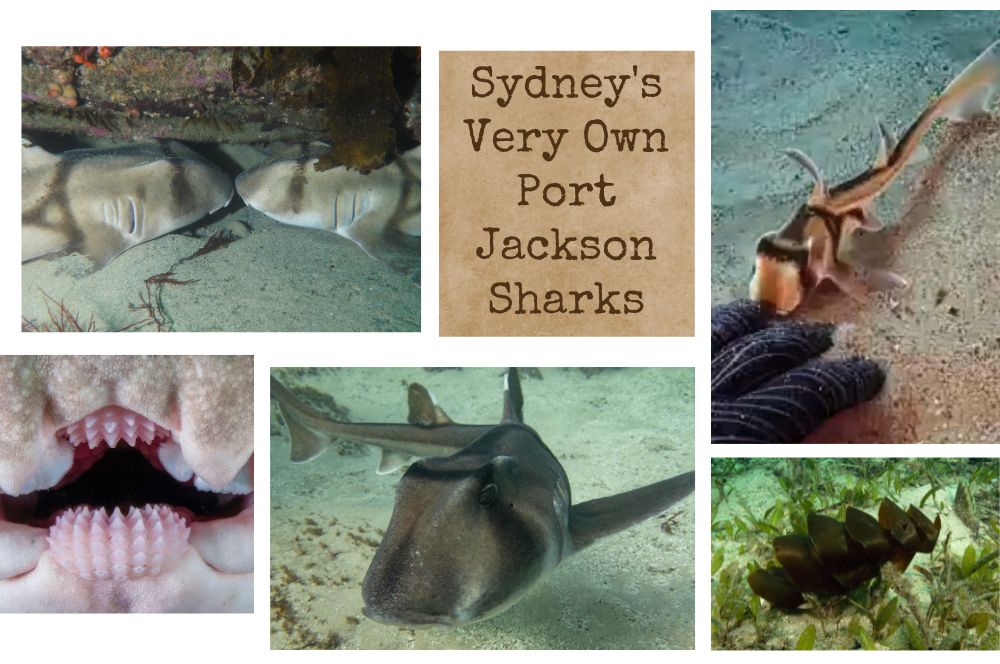
Unmasking the Mystery: Sydney's Very Own Port Jackson Sharks
Diving into the depths of Australia's southern waters, we uncover the fascinating world of the Port Jackson shark. This unique species captivates marine enthusiasts with its distinctive appearance, intriguing habits, and surprising intelligence. So, let's embark on an underwater journey to unmask the mystery of Sydney's very own Port Jackson shark, a true gem of the ocean world.
Short Summary
-
The Port Jackson shark is a captivating species native to Sydney's Port Jackson harbour, belonging to the Heterodontidae family.
-
It has distinctive features such as harness-like markings and two types of teeth adapted to its diet, which comprises echinoderms, crustaceans and molluscs.
-
Its predation helps maintain the balance of marine ecosystems by controlling populations of prey items while exhibiting harmless behaviour towards humans.
Discovering the Port Jackson Shark
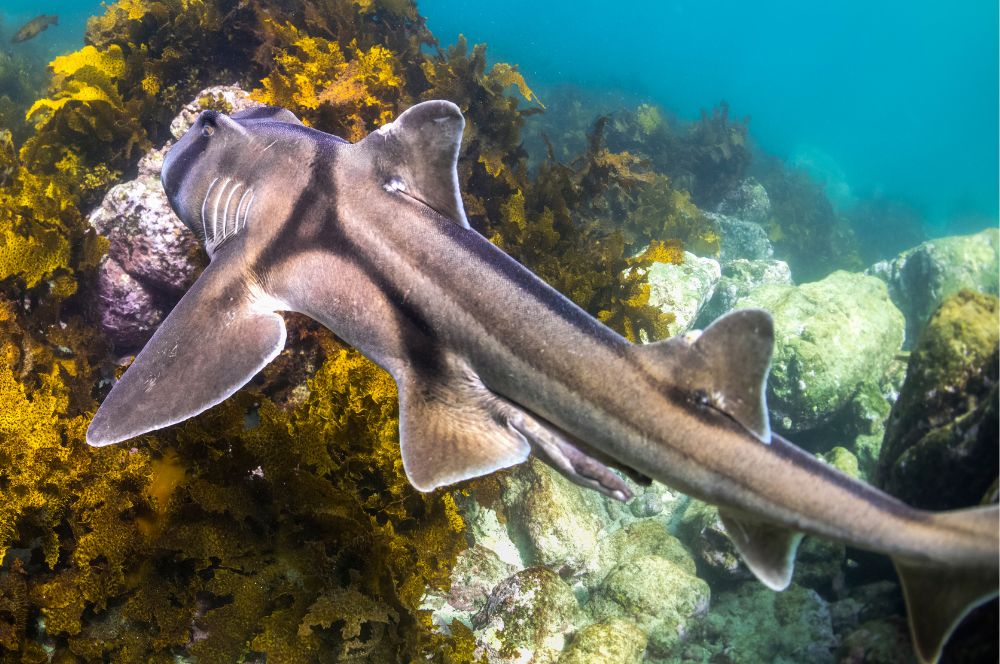
The Port Jackson shark (Heterodontus portusjacksoni) is a captivating shark species named after Sydney's Port Jackson harbour, where it has a long history and holds a special place in the hearts of Australians. A grey characterizes this intriguing shark to light brown body accompanied by black stripes, two dorsal fins with distinctive sharp spines, small sharp teeth and two types of teeth specifically adapted to its diet.
The Port Jackson shark are bottom-dwelling benthic sharks, preferring to feed on molluscs, crustaceans, and small fish. As one of the benthic shark species, it is a relatively small species, growing to a maximum length of 1.2 meters and a maximum weight of 8.5 kilograms. It is also a relatively long-term project.
A Dive into History
The Port Jackson shark, bearing the scientific name Heterodontus portusjacksoni, carries the imprint of Sydney's history in its name. Named after Port Jackson, the natural harbour of Sydney, the shark’s title pays homage to this iconic Australian location. Its title stands as a testament to the interweaving of Sydney's marine and terrestrial history, recognizing the unique ecological richness of the area.
Sydney's harbour, Port Jackson, was the site of the first European settlement in Australia in 1788. It was named after Sir George Jackson, one of the three Secretaries of the Admiralty, by Captain Arthur Phillip, the leader of the First Fleet of convict ships from England. Much like the city itself, the Port Jackson shark has grown to represent a vibrant and unique piece of the underwater world, a fitting tribute to a city known for its remarkable beauty, both above and below the water's surface.
Delving deeper into their lineage, Port Jackson horn sharks all belong to the family Heterodontidae, also known as bullhead or horn sharks. Their evolutionary history is fascinating and long-standing, with the family dating back to the Jurassic period, some 200 million years ago. These survivors from the age of dinosaurs have undergone relatively little change over the millennia, carrying forward a set of unique characteristics that set them apart in the world of sharks.
In particular, the Port Jackson shark is most notable for its distinct head shape, featuring a broad, blunt snout and prominent ridges over its eyes - attributes that are distinctive to bullhead sharks. But perhaps their dentition makes them stand out most amongst their shark brethren. As suggested by the genus name 'Heterodontus', which translates to 'different teeth', these sharks have smaller, sharp front teeth for grasping and larger molar-like teeth at the back for crushing. This dental adaptation enables them to have a varied diet that includes hard-shelled molluscs and crustaceans, unlike many other sharks.
So, when discussing the Port Jackson shark, we are not just discussing a fascinating shark species. We also appreciate a living artifact, a being that carries with it a slice of Sydney's history and a testament to the endurance and adaptability that has characterized life on our planet. As we journey back to the surface and take our next breath, we can't help but marvel at the incredible link between our human history and the natural world that continues to thrive beneath the waves.
Scientific Classification
Belonging to the Kingdom Animalia, Phylum Chordata, Class Chondrichthyes, Order Heterodontiformes, Family Heterodontidae, and Genus Heterodontus, the Port Jackson shark is scientifically designated as Heterodontus portusjacksoni.
This fascinating species, the bullhead shark, is classified as a member of the horn shark family, including the crested horn shark, and its taxonomic classification reflects its unique characteristics and adaptations to its environment among other shark species.
Physical Characteristics
One of the most striking features of the Port Jackson shark is its harness-like markings, which extend for a majority of its body length. The markings begin at the eyes and reach all the way to the first dorsal fin. They are then represented on the remainder of the body. A harness-shaped band encircles the back of the animal. It has two triangular dorsal fins and continues around the pectoral fins and sides. Furthermore, thin, dark stripes are visible on the backs of Port Jackson sharks, progressing from the caudal fin to the first dorsal and anal fin each.
Adult Port Jackson sharks can attain a maximum length of 1.65 meters (5.4 feet), with males averaging 75 centimetres and females 90 centimetres in length. As they mature, females tend to be larger than males, with males measuring between 50 and 80 cm and females between 64 and 83 cm during adolescence. Females reach full maturity at more than 123cm. Males reach full maturity at more than 105 cm.
The dentition of the Port Jackson shark is uniquely adapted to its diet, with small, sharp, and pointy front teeth and flat, broad back teeth. These teeth enable the shark to secure and break and then crush and grind the shells of molluscs and echinoderms, such as sea urchins and large gastropods, which make up a significant portion of their diet.
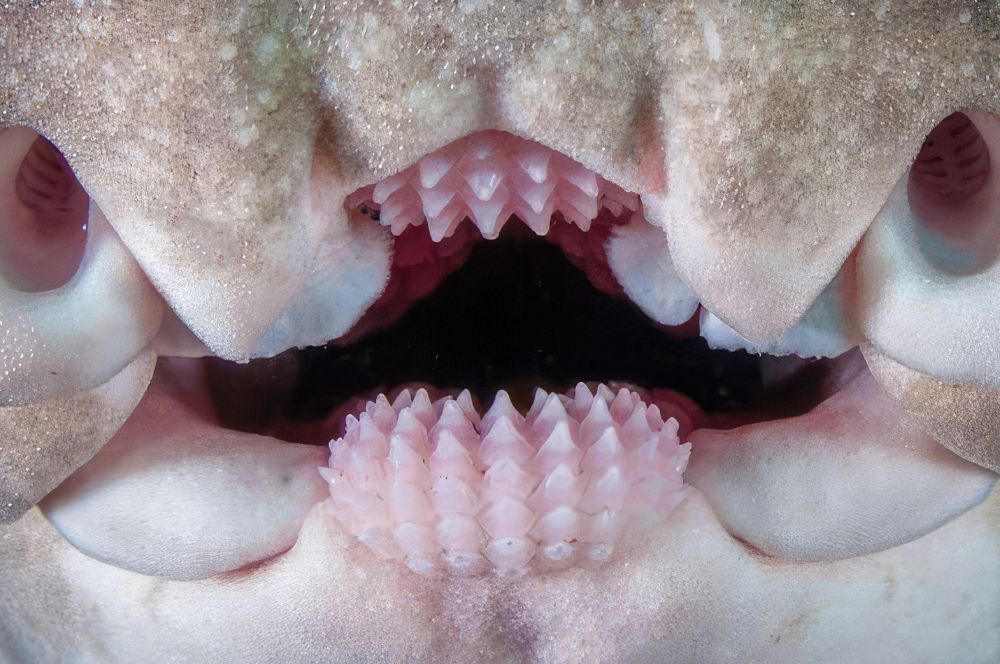
Habitat and Distribution
The Port Jackson shark is found in the waters of Southern Australia. Its territory extends from Queensland to Tasmania to Western Australia's York sound. Rocky environments are the most prevalent habitat for Port Jackson sharks, though sandy, muddy, and seagrass bed habitats are also known to be utilized, providing suitable areas for port jackson sharks forage for food.
Port Jackson sharks are opportunistic feeders, consuming various prey such as bony fishes, crustaceans, cephalopods, and other sharks. They are also known to scavenge for food and have been known to hunt for food.
Depth Range
Port Jackson sharks are typically found in a wide range of water depths, from as little as 1 meter to deeper offshore waters up to 275 meters. While they are often seen in shallow coastal waters and near shorelines, they can also be found in deeper environments. These sharks usually prefer locations with rocky terrains and sandy bottoms, and they have a habit of coming back to the same places year after year.
Migration Patterns
The Port Jackson shark exhibits migratory behaviour, journeying southward after their breeding season concludes in the summer. Following mating, male Port Jackson sharks transition into deeper waters, with females joining them once they have laid their eggs. This migration aids in species dispersion and ensures the perpetuation of their lineage.
It has been noted that these sharks migrate south after breeding and return to the same locations the next year. As part of a citizen science project, Abyss divers tagged a large number of Port Jackson sharks, many of which were found in the waters in Bass Strait and around Tasmania. They then returned to the same breeding sites in Sydney the following year to mate; one shark was still returning to Sydney 20 years later. This impressive homing behaviour underscores the sharks' strong attachment to specific breeding sites and highlights the significance of these areas for their reproductive success.
Diet and Hunting Techniques
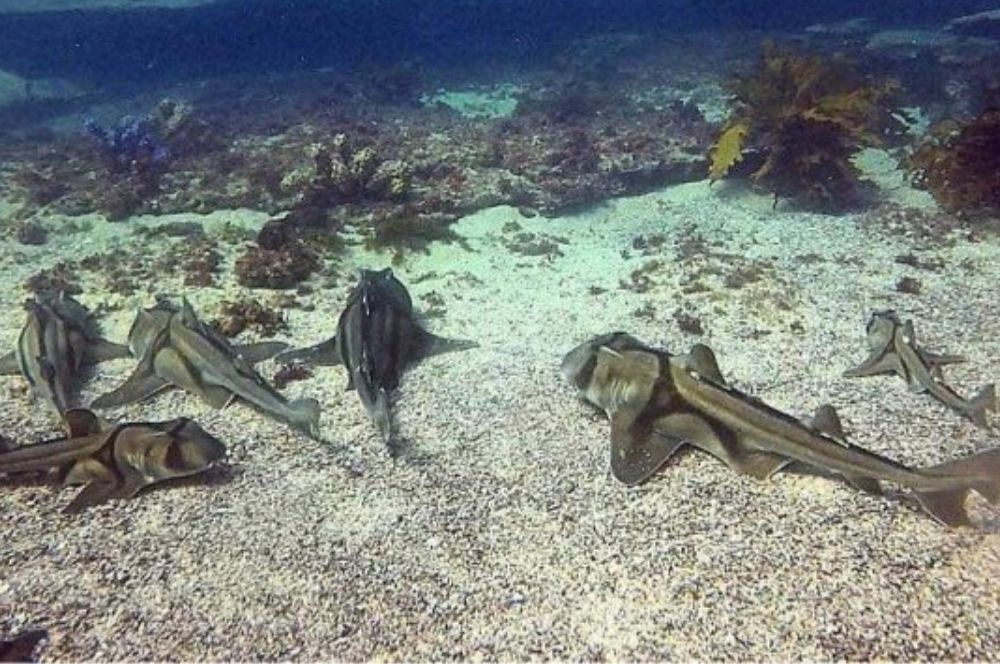
The Port Jackson shark feeds primarily on invertebrates, chiefly echinoderms such as black sea urchins, starfish, sea cucumbers, crustaceans, molluscs, and some small fish.
One of the most intriguing aspects of their feeding behaviour is their ability to feed and respire simultaneously, unlike most sharks that must move with their mouths open to propel water over their gills for oxygen extraction.
Sea Urchins and Other Prey
Studies on the diets of Port Jackson sharks have indicated that they feed primarily on echinoderms, crustaceans, molluscs, and some small fish, with sea urchins and large gastropod molluscs being particularly prominent.
This diverse diet allows them to thrive in their preferred habitats and maintain their status as effective predators within the marine ecosystem.
Nocturnal Foraging
The Port Jackson shark engages in foraging activities during the nighttime when its prey are most active, and it typically utilizes caves and rocky outcrops as a means of protection during the day. This nocturnal behaviour allows them to capitalize on the availability of their preferred food sources and maximize their hunting efficiency.
Juvenile Port Jackson sharks have a unique method for extracting food from the sand. They suck in water and sand, then blow it out of the gill covers, effectively filtering out small invertebrates for consumption. This foraging technique enables them to thrive in their chosen habitats and successfully compete with other marine predators.
Social and Reproductive Behavior
Port Jackson sharks, including female Port Jackson sharks, are known to form large mixed and same-sex groups, which congregate briefly during mating season in inshore reef areas. Females typically lay their eggs in shallow reefs at depths of about 5 meters. The egg-laying process usually happens during the months of August and September. This provides ideal conditions for the survival and development of their offspring.
Same-Sex Groupings
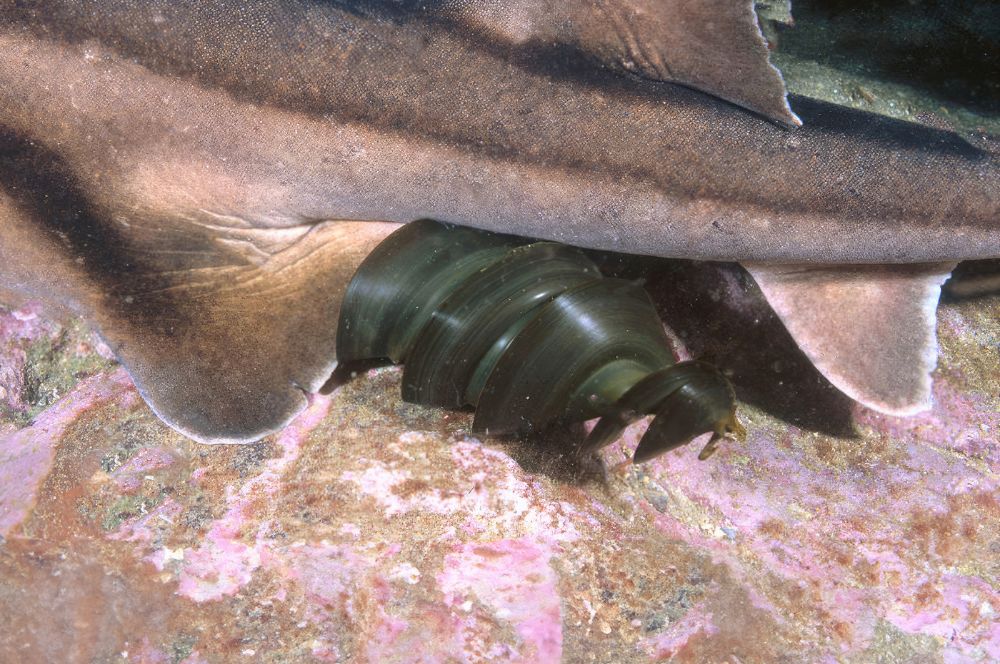
The segregation of Port Jackson sharks into same-sex groups may affect the species reproductive success, as well as on the general well-being of female and male groups within the population. While the reasons behind this behaviour are not yet fully understood, it is clear that these groupings play a significant role in the species' social structure and reproductive strategies.
Studies have shown that the presence of same-sex groups can lead to increased mating opportunities and protection from predators. This suggests that the segregation of Port Jackson sharks into same-sex groups may be an evolutionary adaptation to ensure the species' survival.
Breeding Season
The breeding season of the Port Jackson shark occurs from late August to mid-November, during which time they mate and lay their eggs in coastal reef areas. Females lay a pair of eggs every 10 to 14 days, securing them in rock crevices where they will develop and eventually hatch after 10 to 12 months.
The hatching period for Port Jackson shark eggs is lengthy, allowing the young to develop within the safety of their egg cases before emerging into the ocean. Once hatched, the young sharks face numerous challenges, including high egg capsule mortality rates and predation by other marine species.
Despite these obstacles, the species continues to thrive in its chosen habitats, showcasing its resilience and adaptability in the face of adversity.
Juvenile Port Jackson Sharks
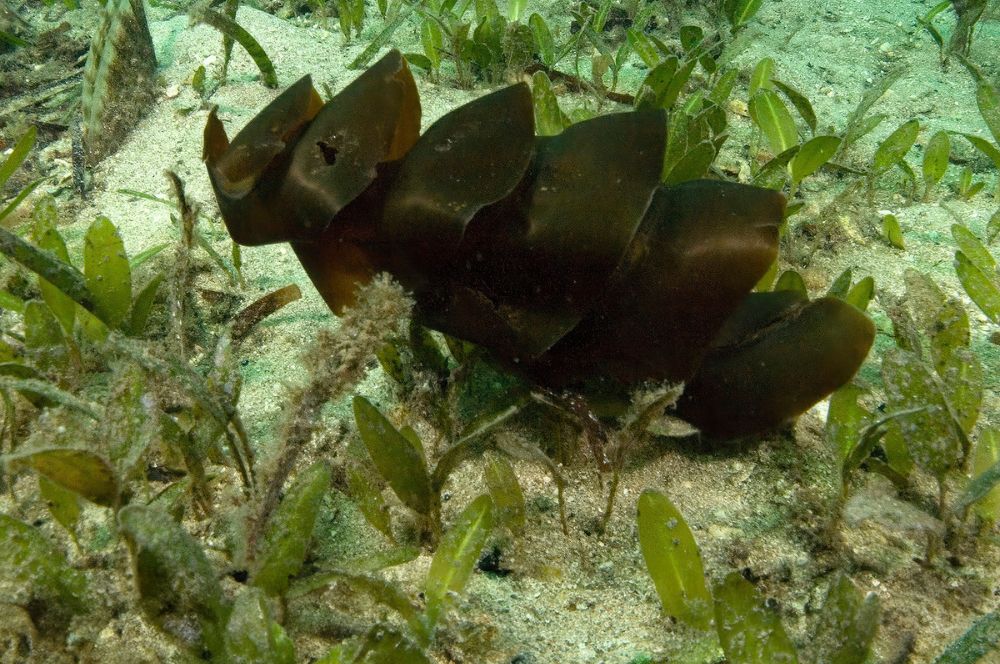
Port Jackson sharks exhibit oviparous reproduction, meaning the females lay eggs from which the offspring later hatch. Each egg is encased in a distinct spiral-shaped egg case or 'mermaid's purse', a unique adaptation allowing the mother to wedge the eggs into crevices to protect against predators. This spiral casing is one of the first things that make juvenile Port Jackson sharks stand out, even before they take their first swim in the ocean.
Once the juvenile sharks emerge from these egg cases, they already closely resemble adults but at a fraction of the size, typically measuring around 25 cm in length. They carry the same distinctive markings as their older counterparts - dark brown bodies with lighter, harness-like markings across their backs and down their sides.
One of the intriguing aspects of juvenile Port Jackson sharks is their ability to fend for themselves immediately after hatching. With no maternal care in their early days, these young sharks are born survivors. They are equipped with a full set of teeth and are able to hunt small prey right from the start.
Despite their immediate independence, juvenile Port Jackson sharks are not without their vulnerabilities. In their early years, they are at greater risk from predators, including larger fish and other shark species. To mitigate this risk, they often reside in shallow, inshore waters, with plenty of crevices and hiding spots. It is here that divers are most likely to encounter these young inhabitants of the sea.
The juvenile stage of a Port Jackson shark's life offers a captivating glimpse into the resilience and adaptations of this remarkable species. From their unique egg cases to their early independence, each aspect of their juvenile life underscores the evolutionary journey of the Port Jackson shark. So, next time you dive, spare a thought for these young dwellers of the deep, and marvel at their small but significant presence in Sydney's marine world.
Interaction with Humans and Conservation Efforts
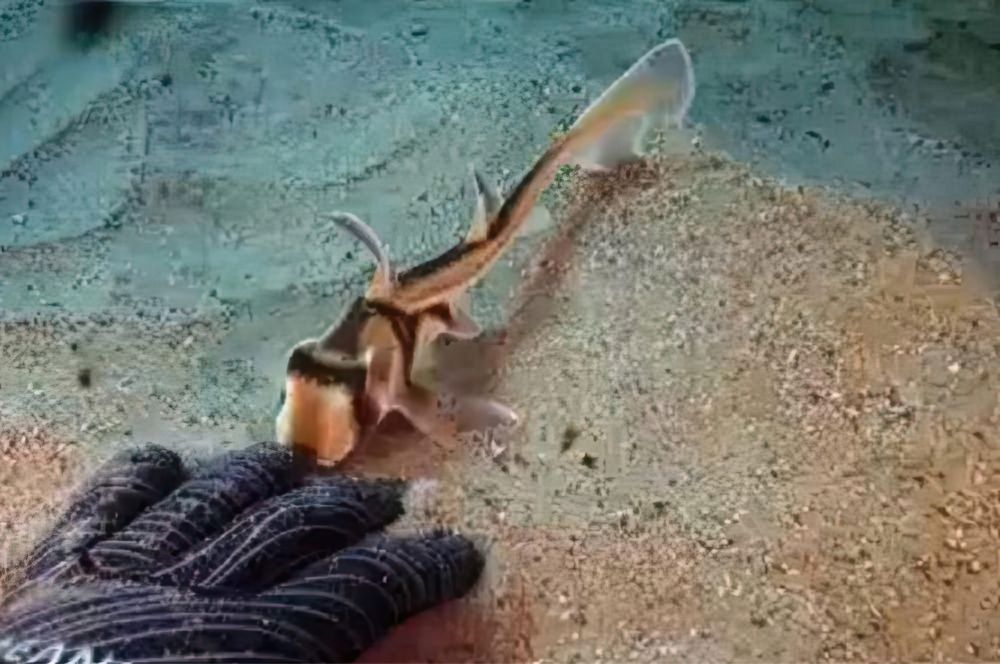
Though Port Jackson sharks are not of commercial interest or considered endangered, they are commonly caught in southern Australian fisheries and are often kept in captivity. They are listed as "Least Concern" on the International Union for Conservation of Nature (IUCN) Red List but have high egg capsule mortality rates and face threats from unknown predators.
These threats, combined with their low reproductive rate, make them vulnerable to population declines. Conservation efforts are needed to ensure their long-term survival.
Port Jackson sharks are generally considered harmless to humans, and while their teeth can inflict a painful bite, there have been no reported incidents of serious injury.
This benign nature, unique appearance and captivating behaviour have contributed to their popularity among marine enthusiasts and researchers.
Conservation Status
The Port Jackson shark is listed as "Least Concern" on the IUCN Red List, indicating that the species is not currently facing any immediate threats to its survival. However, the high egg capsule mortality rates and unknown predators pose challenges to conserving this species.
In Western Australia, a bag limit of four Port Jackson sharks per recreational trip has been established to ensure this fascinating species' continued survival and well-being.
The Role of Port Jackson Sharks in Marine Ecosystems
As significant predators of echinoderms and crustaceans, Port Jackson sharks play an integral role in maintaining the balance of marine ecosystems. Consuming these invertebrates positively influences molluscs and algae populations, helping preserve the delicate equilibrium of their aquatic habitats.
Port Jackson sharks are known to prey upon various echinoderms, such as sea urchins, starfish, sea cucumbers, and crustaceans like crabs, shrimps, and lobsters.
This diverse diet allows them to thrive in their preferred habitats and maintain their status as effective predators within the marine ecosystem.
In conclusion, the Port Jackson shark is a truly remarkable species that play a vital role in the marine ecosystems it inhabits. From its unique physical characteristics and intriguing hunting techniques to its fascinating social and reproductive behaviours, this captivating shark amazes and inspires marine enthusiasts and researchers. As we learn more about fish biology, the Port Jackson shark's territory, and its role in our oceans, we are reminded of the incredible diversity and beauty that exists beneath the waves, waiting to be discovered and appreciated.
Recent Posts





